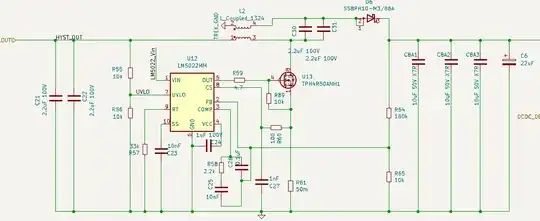I'm designing a circuit that uses a SEPIC controller (LM5022) to switch a power circuit; however, the controller is enabled by a microcontroller and requires ultra-low quiescent current on power down.
Initial designs used the UVLO pin to shut the converter down; however, the quiescent draw was too great (mA when targeting µA) sO I opted to place a FET in front of the controller's power input, whilst the power circuitry remains unswitched by said FET.
When the LM5022 powers up, there's a sudden power inrush, which causes a brownout on the input rail (12V), which causes the CPU voltage regulator to drop out and the CPU to restart. Given this is FET is powered by the CPU is causes an indefinite reboot loop.
Removing in the switching FET at the input and shorting the D/S pins on the running board results in the same behavior. Once the voltage dropout has occurred, everything recovers and the board runs fine. The bootstrap cap has a very low value, but I'm trying to work out what to test and why this is happening, is it:
- The LM5022 has a high inrush charging the internal charge-pump and bootstrap?
- The LM5022 starts regulating and the decoupling caps start charging?
- Something else?
Power supply circuitry should be ample to deal with anything this circuit throws at it, so this has me beat! Any ideas
